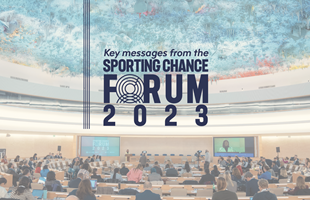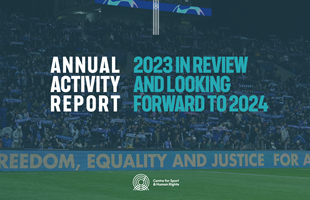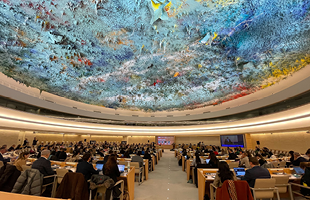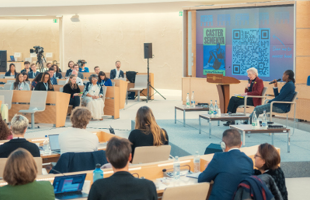Sporting Chance Forum, Child Rights Session, Geneva 22 November 2019
29 Nov 2019
Author - Maud de Boer-Buquicchio
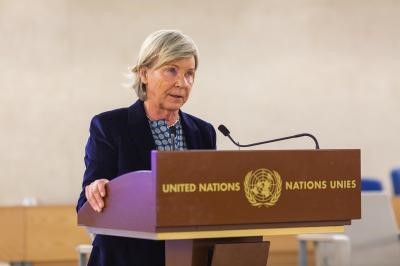
The Sporting Chance Forum, held on 21st and 22nd November in Geneva in the historic Room XX of the UN Palais des Nations, serves as a powerful opportunity to discuss the key human rights issues, and their solutions, that exist across the world of sport.
Hosted by The Centre for Sport and Human Rights, International Labour Organization, Office of the UN High Commissioner for Human Rights, and UN Office in Geneva, the programme explored how different actors in the world of sport can use their individual and collective leverage to achieve a world of sport that fully respects human rights.
Following the release of a user-friendly version of her 2018 report, Playing It Safe UN Special Rapporteur on the sale and sexual exploitation of children Maud de Boer-Buquicchio delivered an important speech on the challenges of addressing child rights in sport.
Many if not all of us in this room in one way or another are connected with sports. We practise it as leisure or as professionals and it makes us feel good if we perform well. Physical challenges if met and team spirit when practised come with a reward, with benefit for our body and for our soul, and will make us stronger in many respects. This is especially true for children, everywhere in the world. Yesterday, during the UN GA celebrations of the 30th anniversary of the CRC in New York, we heard Yanné, an 11 year young boy affected by spinal muscular atrophy, answer a question by Jordi Cardoner, Chairman of FC Barcelona and President of the Barca Foundation, on what skills he had learned from football that have had a positive impact on his life. His answer was: leadership, passion and team play. Nobody could have said this better than he.
Ladies and Gentleman, dear friends,
Overall, sports convey a positive image. And yet sports has its dark side, especially when it comes to children. In sport at all levels, children have a right to play safely and to be secure. But for some children, the reality is quite different. Sale and sexual exploitation of children occur in all parts and settings of society, around the world, and sports are no exception. The power dynamics inherent to the sporting world render children particularly vulnerable to abuse and exploitation and make the reporting of these cases difficult.
In my Report which I presented to the HRC last year, and of which an easily readable version is available in the room today, I have had a closer look at situations in which children practising sports fall into traps and experience abuse or exploitation.
Let me start with the concept of «sale», prohibited by Article 35 of the CRC almost universally ratified and the OP-SC, ratified by 176 countries in the world.
The sale of child athletes for competitive training and ultimately profit, amounts to a form of sale of children for the purpose of forced labour. It generally features an imbalance of power, in which financial power is used to draw children and their families who are in economic hardship into unfair practices over which they have no control. Recruiters may then treat child athletes as commodities with no rights, whose “value” depends on their capacity to work and from which they expect to make a rapid profit.
Children are often transferred from one country to another and find themselves in an unknown setting, with an uncertain legal status, which binds them to their employer. They may be traded from club to club and forced to train intensively, under the threat of finding themselves undocumented, having their dreams crushed and with no resources.
Reports have emerged of children being recruited in developing countries and sold to play in basketball or soccer teams. Behind such recruitment there is a system involving coaches, recruitment agencies and high-level financial transactions, with some children being kept in poor living conditions, ending up in very difficult situations if they do not succeed in securing placement in a team and having to pay huge fees to their coaches. The absence of clear contractual relationships, disregard of regulations regarding transfer of minors, mechanisms of third party ownership and/or trafficking of children are all indicative of children being treated as commodities and commercial assets, exposed to exploitation. Third-party ownership has been banned in football and soccer. However, the practise continues and again, exploitation is a likely outcome. Young talents enrolled in football academies frequently face abuses with arduous schedules and little or no say in their career choices. Children recruited in these academies are considered to be commodities and «venture capital». Even if transferred to big clubs once they turn 18, they will generally be immediately loaned out to other smaller clubs on third party owner schemes, with no say on their destinies, in direct violation of the FIFA ban.
The second area which I addressed is that of sexual abuse and exploitation of children in the context of sports. Every day new stories emerge about the sexual abuse and exploitation of young people in the very space they should have no fear: their playing fields, their gymnasium, their swimming pools, their locker room. Abusers are their coaches, team doctors, and others who are in contact with them. The abuse spans the full spectrum of sports and has no gender or geographic boundaries.
What makes children particularly vulnerable is the unvetted access to them of adults with perverse intentions. Screening mechanisms, if in place, are inadequately implemented and at-risk situations are being created if children are not in their familiar environment, like trips away, or in the cars of a coach. And reporting conditions are far too often not met: children are afraid to report for reasons of fear and shame.
So what needs to be done?
Increased awareness of these practises at the level of Governments, sports federations and civil society should provide a beginning of a response.
The international legal framework sets clear obligations for States and responsibilities for private actors such as sports organizations to deal with these human rights violations. Those laws range from the UN Convention on the Rights of the Child, the Optional Protocol on the sale of children, child prostitution and child pornography, to ILO standards, as well as international statutes pertaining to trafficking, organised crime and tourism ethics. The latter dimension has recently been enhanced by the adoption of the UN World Tourism Organization’s Framework Convention on Tourism Ethics. The Framework Convention adds to the existing body of international law devoted to tackling this grave problem. It provides that tourism activities should promote the rights of the child. The Framework Convention also requires States parties to combat and penalize the exploitation of children, especially sexual exploitation.
The challenge lies with the effective implementation of these obligations and responsibilities to ensure that the best interests of the child serve as a fundamental principle throughout the practice of sports. The recently adopted Guidelines on the OP-SC provide an additional layer of clarity on the implications of this text for the world of sport.
The Guiding Principles on Business and Human Rights endorsed by the Member States in 2011 with its three pillars, including corporate responsibility and access to remedy should be the authoritative benchmark for States and sports organizations.
So, as you see, there is a plethora of safeguards, standards, regulations, policies, and codes of conduct dealing with the rights of the child in the context of sports. Nonetheless, different approaches are followed and there is no standard use of terminology, which leads to inconsistencies and may weaken protection.
Regarding prevention and remedy efforts, I have emphasized the need for independent reporting mechanisms within sports organizations and the implementation of reporting obligations, in close coordination with existing national child protection frameworks. I wish to insist on the crucial role of background checks for anyone working with children.
In the context of major sporting events, there are numerous human rights violations affecting children living in the neighboorhood of stadia, such as forced displacement, sexual exploitation, and child labour, impacting the right to education and adequate housing. It is consequently crucial to systematically include human rights due diligence criterion in bids for such events.
In my report, I have also underlined the importance of ensuring that the practice of sports, in particular at the elite level, does not amount to child labour. In this respect, the right to education is fundamental and appropriate measures must be taken to guarantee balanced tuition that does not sacrifice the learning of other skills beyond proficiency in sports.
Let me hasten to add that everything I’ve said in my report and here today applies to all child athletes, not only those at the elite level. Since finalizing my report I have heard too often « this does not concern us», in particular from parents and coaches at a community level. My findings and recommendations apply at all levels. Even children in amateur, community-level sporting activities can be abused, harrassed, over-trained, and bullied.
And last but not least, in order to integrate children’s best interest in the practice of sports, it is important to ensure avenues for meaningful participation. There is so much we can learn from them as we are seeing during this Forum.
Let’s work on that together.
I am looking forward to hear your perspectives on these issues.
Thank you.
